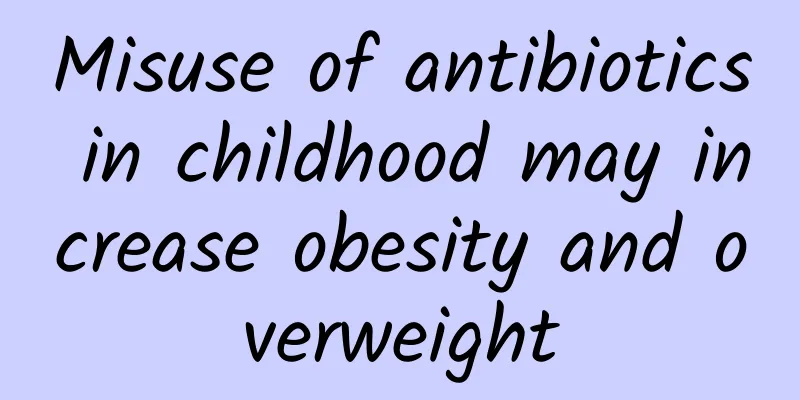Misuse of antibiotics in childhood may increase obesity and overweight

|
Every child is a little angel to his or her parents and the source of joy for the whole family. The health of children is always the top priority of a family. It is a good thing for children to eat more and grow stronger, but being overweight or obese is not good and is also a disease, which must be taken seriously. According to the "Report on the Nutrition and Chronic Disease Status of Chinese Residents (2020)" released by the National Health Commission, the overweight and obesity rates of children and adolescents aged 6-17 in my country are 11.1% and 7.9% respectively, which together account for nearly one-fifth. The overweight and obesity rates of children under 6 years old are 6.8% and 3.6% respectively, which together account for one-tenth. Obesity has already had a great negative impact on the health of adults, not to mention growing children. Obese children often suffer from joint, bone, and muscle damage, and their motor skills and physical fitness are significantly lower than those of children of normal weight. Obesity can even affect intellectual development, causing obese children to have significantly lower intelligence levels than children of normal weight. There are also many metabolic diseases that should not appear at their age. It is not uncommon for children to be diagnosed with fatty liver, diabetes, high blood lipids and other diseases. Obese children are also prone to psychological problems, such as excessive inferiority and loneliness. Figure 1. Trends in the prevalence of overweight and obesity among children and adolescents aged 7 to 18 years in my country from 1985 to 2010 (male) [1]. Childhood obesity is caused by both genetic and environmental factors. High-sugar and high-fat diets and lack of exercise are well-known environmental factors that cause childhood overweight. In recent years, scientific research has brought to light a new environmental factor: antibiotics . Epidemiological studies have found that children who use antibiotics too early or repeatedly in childhood are more likely to suffer from obesity[2]. A recent scientific study has revealed the reasons behind this, showing that the abuse of antibiotics such as penicillin can destroy a type of beneficial symbiotic bacteria belonging to the genus Lactobacillus in the small intestine, affecting the absorption and metabolism of fat in the intestine[3]. But isn’t lactic acid bacteria a type of bacteria? How can it affect the absorption of our digestive system? In fact, some bacteria can directly help us break down large molecules of cellulose or fat, and some bacteria can change the metabolism and absorption of intestinal cells by secreting some unique substances. The symbiotic bacteria of the genus Lactobacillus affect fat metabolism through the second pathway. Some lactobacilli can synthesize a bacterial metabolite called phenyllactic acid , which can promote the expression of peroxisome proliferator-activated receptor-γ (PPAR-γ) in intestinal epithelial cells. This key receptor is involved in the decomposition, synthesis, and transportation of various metabolites such as fatty acids, cholesterol, glucose, and amino acids in the intestine, including reducing the absorption of triglycerides and their accumulation in the blood. The triglyceride level in the blood is one of the indicators of obesity. Excessive triglycerides can lead to hypertriglyceridemia and other cardiovascular diseases [3]. Therefore, ensuring the normal function of this receptor can make us less likely to gain weight. However, when antibiotics are combined with a high-fat diet, a large number of lactobacilli are killed, the synthesis of phenyllactic acid is greatly reduced, and the activity of small intestinal epithelial cells is also disrupted. Not only is the expression of PPAR-γ impaired, but the expression of approximately 200 genes involved in lipid digestion and absorption is affected to varying degrees, and obesity and metabolic dysfunction are the consequences. Figure 2. Antibiotics destroy intestinal flora, leading to disorders in fat metabolism and absorption [4]. So why is childhood obesity more susceptible to antibiotics? In fact, everyone is almost sterile when they first come into this world. Through contact with the outside world, bacteria gradually appear on our skin and in our intestines. The types of intestinal microbiota in our early life are very limited. As the baby grows, especially after weaning and starts to eat a variety of foods, the complexity and richness of the intestinal flora rise sharply. 1-3 years old is the critical period for the maturation of intestinal flora, which is very sensitive to the composition of the diet and the use of antibiotics. At this time, frequent use of antibiotics is more likely to cause intestinal flora disorders, and such "bad" flora will even accompany us for a long time. Children aged 3-5 have formed flora similar to those of adults, and the composition tends to be stable. At this time, the intestinal flora is more tolerant to interference from external factors, but frequent use of antibiotics will still cause considerable damage and lead to flora imbalance. It is worth mentioning that the experimenters also found that additional supplementation of Lactobacillus or phenyllactic acid after using antibiotics can effectively slow down weight gain and improve the symptoms of obesity. There is hope to launch clinical trials and develop new drugs for the treatment of childhood obesity. Of course, the use of antibiotics not only affects the content of lactobacilli, but also destroys the growth of other intestinal symbiotic bacteria. The normal metabolism of lipids and proteins is the result of the coordinated cooperation of the bacterial flora. The role of other symbiotic bacteria in the metabolic process and their relationship with the use of antibiotics are the next key research topics for scientists. Although this study was done in a mouse obesity model, many of the changes in gene expression are consistent with obese patients. It not only shows how the microbiota communicates with intestinal epithelial cells in early life, providing new evidence for the relationship between early antibiotic exposure and childhood obesity, but also provides new ideas for the treatment and prevention of childhood obesity and overweight. References 2.Ajslev TA, Andersen CS, Gamborg M, Sørensen TI, Jess T. Childhood overweight after establishment of the gut microbiota: the role of delivery mode, pre-pregnancy weight and early administration of antibiotics. Int J Obes (Lond) 2011;35:522–9. doi: 10.1038/ijo.2011.27. 3.Duszka, K.; Oresic, M.; Le May, C.; König, J.; Wahli, W. PPARγ Modulates Long Chain Fatty Acid Processing in the Intestinal Epithelium. Int. J. Mol. Sci.2017,18,2559. https://doi.org/10.3390/ijms18122559 4.Catherine D. Shelton, Elizabeth Sing, Jessica Mo, et. al., An early-life microbiota metabolite protects against obesity by regulating intestinal lipid metabolism, Cell Host & Microbe, 2023. This article is produced by the Science Popularization China Creation Cultivation Program. Please indicate the source when reprinting Cover image source: Pinterest |
<<: Rheumatoid arthritis: a battle against pain
>>: Popular Science on the Past and Present of Cervical Cancer
Recommend
How much does it cost to do an HPV test
HPV testing is mainly a way to detect human papil...
Who is Zhang Chengcheng's child in An Jia? What is Zhang Chengcheng's ending like?
As the holiday is extended, more and more TV dram...
How long does it take to stop taking progesterone injections?
Progesterone is an important indicator of the phy...
Which is better, minimally invasive abortion or painless abortion?
Minimally invasive abortion and painless abortion...
Female vagina structure diagram
For female friends, they all know that reproducti...
Can gardenias be grown outdoors in winter? How to grow gardenias well?
Gardenia is very common in life. Many people like...
Women are most likely to get angry during these nine periods
Anger is a violent emotion, and people tend to ma...
Following the "rounding off" rule can help you avoid menopause
The latest statistics show that women's menop...
Check whether you can have children
If you haven't gotten pregnant for a long tim...
How many eggs can a pregnant woman eat in a day
Eggs are very nutritious. They are rich in protei...
Reasons for missing menstruation for 45 days
Menstruation is something that every woman must f...
Is hot water bottle effective for dysmenorrhea?
When a woman starts menstruating during puberty, ...
A young football player suddenly suffered brain death during overseas training. Is this the same as being in a vegetative state?
Recently, there is a heart-wrenching news - 18-ye...
What are the effects and functions of chrysanthemum tea? How to brew chrysanthemum tea correctly?
Generally speaking, chrysanthemum tea cannot be d...
Pregnant women's nipples cracked
During pregnancy, pregnant women will experience ...









